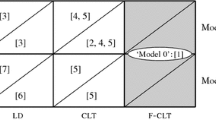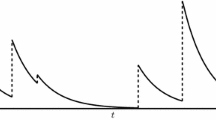Abstract
Some basic results of the renewal model are effectively summarized by
wherex is the random variableservice time, r is its associatedresidual time, Ψ ( ) is an arbitrary “well behaved” function, andE is the expectation operator. The process “waiting time for service of a new arrival”, denoted byw, is effectively summarized in the modelM/G/1 by
We refer toEΨ (Z) as theomni-transform of the random variable or processZ, and to equations typified by (2) asomni-equations, i.e. equations valid for an arbitrary well-behaved functionΨ ( ). The omni-transform owes its flexibility to the arbitrariness ofΨ ( ) and its ease of handling to its simplicity when applied to mixtures and sums of random variables. From (2) we obtain the moments ofw by puttingΨ (w)=w k, the Laplace transform ofw by puttingΨ(w)=e−sw, and the convolution equation (2a) for the distribution ofw by puttingΨ(w)=1 ifw≥t andΨ(w)=0 otherwise:
a result equivalent to the Takacs integro-differential equation. Using repeatedly the so-called shift property of omni-equations, (2a) can be solved by representing the distribution ofw as an infinite series of convolutions:
where ther i are a set of independent random variables, each distributed liker. Equation (3) is equivalent to a theorem by Benes. An analogy between the process “waiting time inM/G/1” and the process “toss a coin till heads shows up” where the tossing time is a random variable is also pointed out. The omni-calculus also sheds some light on the modelG/G/1. In forthcoming publications, we will apply the omni-calculus to the process “number in queue” inM/G/1, to the analysis of the busy period inM/G/1, and to some modifiedM/G/1 models, e.g. a vacationing server. In these publications too, the omni-method lifts the “Laplace veil” from much of the physical reality underlying the models considered.
Similar content being viewed by others
Abbreviations
- x :
-
service time
- r :
-
residual time (“residue”) ofx;x andr are related through the omni-equationEΨ(x)−Ψ(0)=E(x)EΨ′(r), cf. (1.4)
- w :
-
backlog (unfinished work) encountered by an arrival; it is the point process “waiting time for service under the protocol first-come first-served” inG/G/1
- w + :
-
backlog encountered by an arrival who finds the server to be busy
- W :
-
backlog just after an arrival, a point process;W=w+x, wherew andx are independent random variables; a customer's sojourn inG/G/1
- u :
-
backlog as observed at a random instant
- u + :
-
backlog as observed at a random instant provided that the server is busy
- λ :
-
arrival frequency
- μ :
-
1/E(x)
- ρ :
-
λ/μ
- P j :
-
probability that there arej customers in the system at a random instant
- Y :
-
server's backlog; cf. (1.1) and (2.0)
- Ψ( ):
-
is an arbitrary “well-behaved” function of its argument
References
V.E. Benes, On queues with Poisson arrivals, Ann. Math. Stat. 28(1956)670.
D. Gross and C.M. Harris,Fundamentals of Queueing Theory (Wiley, New York, 1974, or 2nd edition, 1985).
M. Krakowski, Conservation methods in queueing theory, Revue Francaise d'Automatique, Informatique et Recherche Operationelle V-1 (1973).
M. Krakowski, Omni-transforms: Applications to renewal theory, University of Virginia Report No. UVA/525393/SE84/103 (1984).
L. Takacs, A single-server queue with Poisson input, Oper. Res. 10(1962)388.
R.W. Wolff, Poisson arrivals see time averages, Oper. Res. 30(1982)223.
Author information
Authors and Affiliations
Additional information
The work leading to this paper was sponsored by the U.S. Office of Naval Research under Contract N00014-83K-0624 to the University of Virginia.
Rights and permissions
About this article
Cite this article
Krakowski, M. The omni-transform in the renewal model and in single-channel queues. Ann Oper Res 8, 75–92 (1987). https://doi.org/10.1007/BF02187083
Issue Date:
DOI: https://doi.org/10.1007/BF02187083




